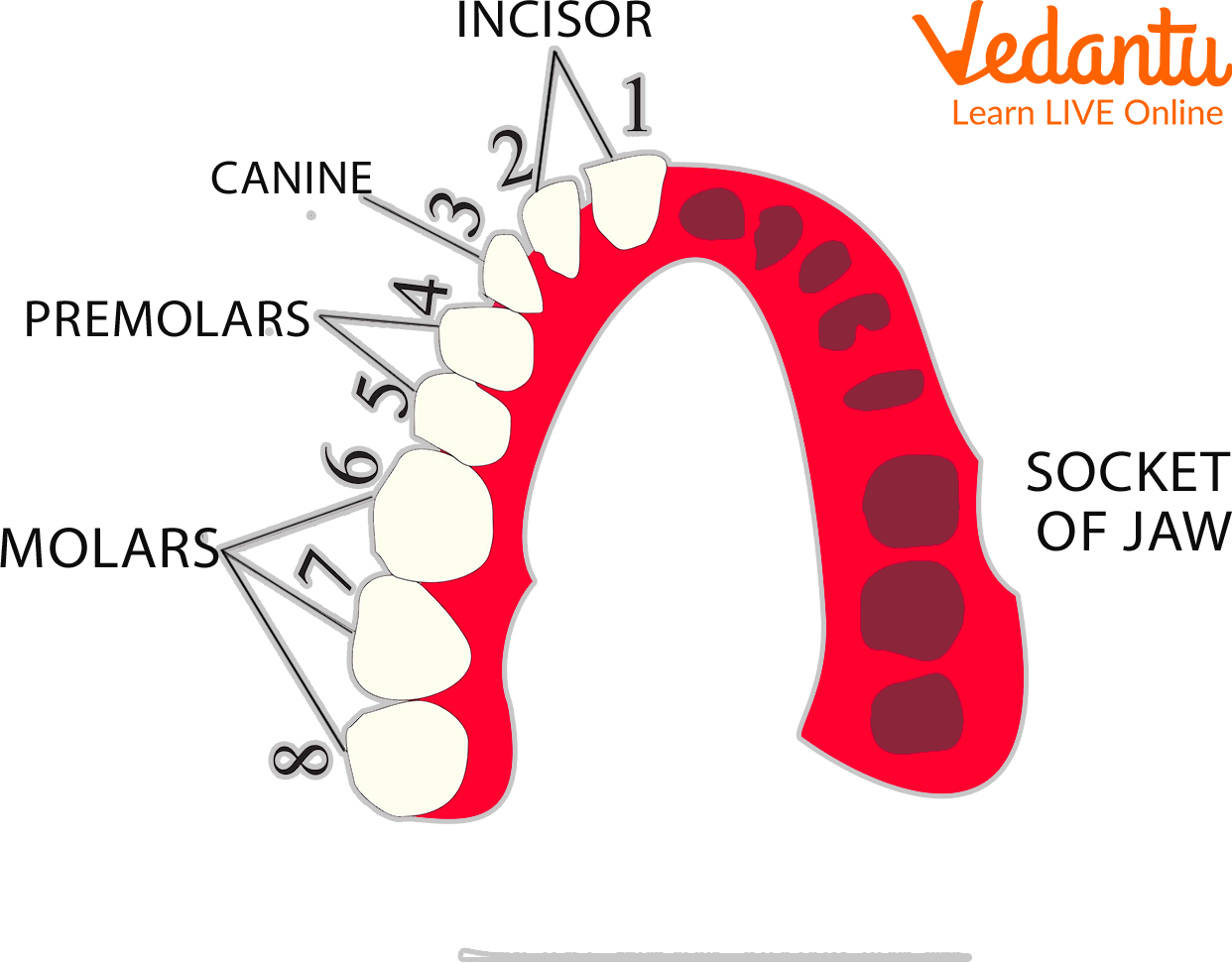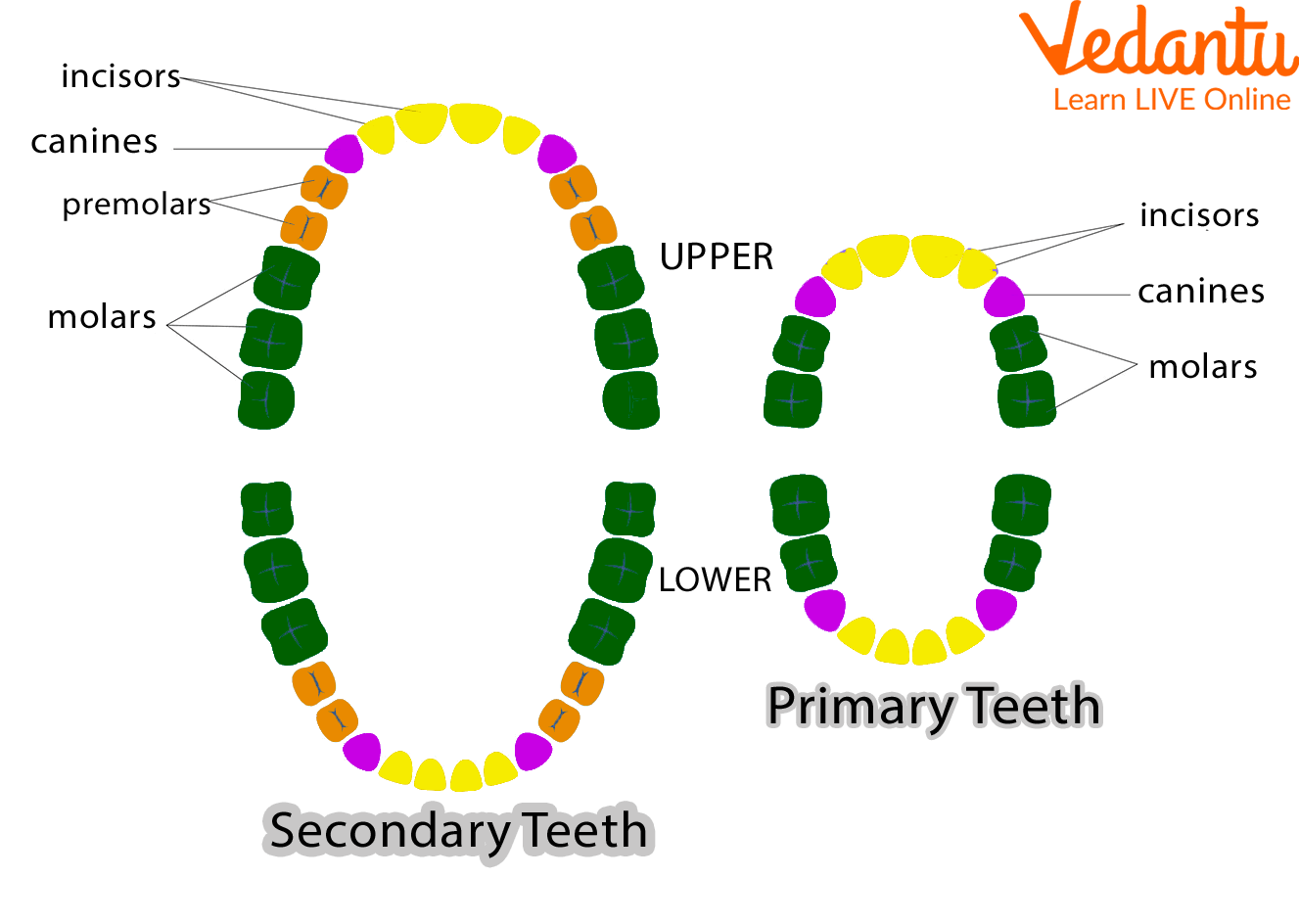




What Are the 4 Types of Teeth and Their Roles?
Teeth are structures made up of calcium and certain proteins and are one of the strongest parts of our body. These are mainly used for tearing, chewing, and grinding of the food that we eat. It also is needed for speaking clearly. Teeth appear in two sets in humans.
The first set that appears is known as milk teeth and is only 20 in number. These teeth start to appear in a child post 6 months of birth and all of them appear till age 3.These teeth get loose and then fall off after age 6 and are replaced by new permanent teeth. Permanent teeth as the name suggests stay for a lifetime.
Types of Teeth
A healthy adult is known to have a total of 32 teeth. There are a total of 8 incisors, i.e. 4 incisors in the upper jaw and 4 incisors in the lower jaw. There are 4 canines, i.e. 2 canines in the upper jaw and 2 in the lower jaw. There are 8 premolars, i.e. 4 premolars in the upper jaw and 4 in the lower jaw. And finally, there are 12 molars, i.e. 6 molars in the upper jaw and 6 in the lower jaw.

Arrangement of Teeth in a Jaw
Incisors
There are a total of eight incisor teeth and all of them are in the frontal part of the mouth. These teeth are small chisel-like. The ends are very sharp and are used to take a bite of the food.
When we bite a fresh apple or guava the marks formed on the fruit are of our incisors as it cuts out a portion of the fruit and thus we chew it with the rest. These are the first teeth that appear in kids at about 6 months of age. Adult incisors are known to appear between the age of 6 and 8.
Canines
The canines are seen placed next to the incisors on the upper and lower jaw.
There are two canines on the upper jaw on either side of the incisors and two on the lower jaw on either side of the incisors.
These are very sharp, pointed in shape and are mainly used for tearing the food.
These are mostly used while biting meat and any other rough and hard food item.
The canines start to appear in a baby at about 16 months and 20 months of age.
The canines on the upper jaw appear first and thereafter the lower jaw canines.
The canines in adults appear in the opposite manner.
It begins with the lower canines and the lower canine appears at age 9 and thereafter the upper canines appear at around the age of 11 or 12.
Premolar
There are a total of eight premolars present right beside the canines. There are a total of four premolars on the upper jaw and four premolars on the lower jaw. Premolars are large rectangular teeth and are larger than the canines and incisors.
They are mostly flat with ridges on the upper surface used for crushing and grinding the food and converting them into fine small pieces and that makes it easier for us to swallow. Babies do not have any premolars, their molars are replaced with a set of premolars when they grow a little old.
Molars
These are known to be the biggest and strongest teeth in our jaws.
We have a total of six on the upper jaw and three on either end of the jaw.
And six on the lower jaw and 3 each at either end of the jaw.
The large surface area is used for the grinding of the food.
As we take a bite and begin chewing, the tongue pushes food towards these molars for proper grinding. This grinding makes the food fine and particles small enough for ease of swallowing.
Summary
An adult human being has 32 teeth in mouth. In childhood, all humans have milk teeth then these milk teeth get replaced by permanent teeth. Between the age of 17 to 25 wisdom teeth appear absolutely at last. The enamel of the teeth is the toughest part of the entire body and it can be much harder than the bones. The one third of the teeth are mostly under the gums and that is why they are so solid.

Primary Teeth and the Permanent Teeth Set
FAQs on Teeth Names: Complete Guide to Types and Functions
1. What are the four main types of human teeth and their specific functions?
Humans have four types of teeth, each specialised for a different role in processing food:
- Incisors: These are the eight sharp, flat teeth at the front of your mouth (four on top, four on bottom) used for biting and cutting food into smaller pieces.
- Canines: Located next to the incisors, these four pointed teeth (two on top, two on bottom) are the sharpest and are used for tearing and ripping tough foods.
- Premolars (Bicuspids): Behind the canines are eight premolars. They have a flatter surface than canines and are used for crushing and grinding food.
- Molars: At the very back of the mouth are the twelve largest teeth. Their broad, ridged surfaces are ideal for the final, intensive grinding of food before it is swallowed.
2. What is the overall importance of teeth beyond just chewing food?
While the primary importance of teeth is for mastication (chewing) to begin the digestive process, they serve other vital functions. Teeth are fundamental for speech and articulation, helping to form sounds correctly. They also provide structural support for our facial muscles, giving shape to our lower face, and are essential for a confident smile.
3. What is the difference between milk teeth and permanent teeth?
The key differences between milk teeth (primary dentition) and permanent teeth (secondary dentition) relate to their number, timing, and structure.
- Milk Teeth: A child develops a set of 20 milk teeth. These are the first teeth to emerge and are generally smaller and less strong. They act as placeholders and begin to fall out around age 6 to make way for the permanent set.
- Permanent Teeth: An adult has a full set of 32 permanent teeth, including wisdom teeth. These teeth are larger, stronger, and are meant to last a lifetime with proper care.
4. Why do humans have different shapes of teeth instead of just one uniform type?
Humans have different shapes of teeth because we have an omnivorous diet, which includes a wide variety of food textures. Each tooth shape is an evolutionary adaptation for a specific task, making digestion more efficient. Sharp incisors are for cutting, pointed canines are for tearing, and broad molars are for grinding. This specialisation allows us to effectively break down everything from soft fruits to tough meats and fibrous vegetables, which would be difficult with only one type of tooth.
5. How does the specific structure of a molar make it perfect for grinding?
A molar's structure is perfectly designed for its grinding function. It has a large, wide top surface with several pointed bumps called cusps. These cusps and the grooves between them create an uneven, abrasive surface that works like a mortar and pestle. When the upper and lower molars come together, this surface effectively crushes and grinds food particles. Additionally, molars have multiple strong roots that anchor them securely in the jaw, allowing them to withstand the immense pressure of chewing.
6. What is the dental formula for an adult human as per the NCERT syllabus?
The dental formula is a way to represent the number and types of teeth in one half of the upper jaw over one half of the lower jaw. For an adult human, the permanent dental formula is 2.1.2.3 / 2.1.2.3. This represents:
- 2 Incisors
- 1 Canine
- 2 Premolars
- 3 Molars
This combination (8 teeth) is found in each of the four quadrants of the mouth, totalling 32 teeth.
7. Are wisdom teeth (third molars) necessary, and why do they often cause problems?
Wisdom teeth are the final set of molars that erupt, typically in the late teens or early twenties. For our distant ancestors, these teeth were necessary to chew coarse, tough foods. However, due to evolutionary changes, modern human jaws are smaller, and wisdom teeth are now often considered vestigial organs (parts that have lost their original function). Problems arise because there is often not enough space for them to grow in properly, leading them to become impacted (stuck), grow at an angle, cause pain, or damage adjacent teeth.















